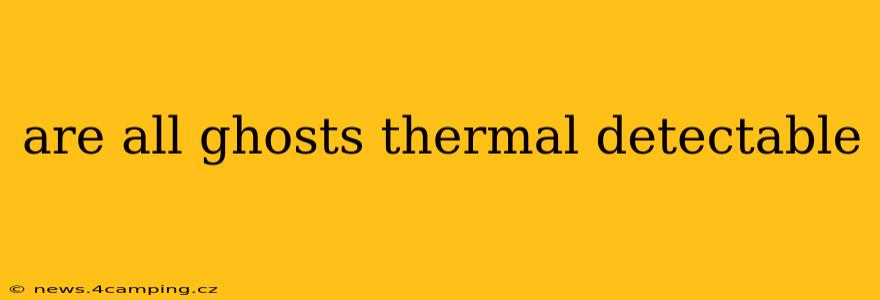Are All Ghosts Thermal Detectable? Unraveling the Mystery
The question of whether all ghosts are thermal detectable is a fascinating one, blending paranormal investigation with the scientific principles of thermal imaging. The short answer is: we don't know. The very existence of ghosts remains unproven, making any definitive statement about their thermal properties impossible. However, let's explore the topic by examining the relevant aspects of both thermal imaging and ghost lore.
What is Thermal Imaging and How Does it Work?
Thermal imaging, or thermography, detects infrared radiation emitted by objects. Warmer objects emit more infrared radiation, appearing brighter on a thermal image. Humans, being warm-blooded, are readily detectable using this technology. This is the basis for many ghost hunting investigations that employ thermal cameras. The assumption is that if a ghost is a physical entity, even an energetic one, it might register as a heat signature.
Why Thermal Imaging Might (Theoretically) Detect Some Ghosts
Proponents of ghost hunting using thermal imaging argue that some reported ghostly phenomena could potentially be detected. For example, some accounts describe "cold spots," areas of significantly lower temperature than their surroundings. A thermal camera could potentially pick up these anomalies, though alternative explanations (like drafts or faulty temperature readings) must be considered. Alternatively, some theories posit that ghosts might manifest energy, potentially detectable as a localized heat increase or decrease.
Why Thermal Imaging Might Not Detect Ghosts
The major challenge with using thermal imaging to detect ghosts lies in the very nature of the phenomenon. Many accounts describe ghosts as ethereal or spectral beings, not bound by the laws of physics as we understand them. If ghosts are purely energy-based or exist on a different plane of reality, they may not interact with infrared radiation in the same way physical objects do. Therefore, they might not produce a detectable thermal signature.
What About Different Types of Ghosts?
There's no scientific classification of ghosts, but folklore describes various types. Some are said to be residual hauntings (recorded events replaying), others are thought to be intelligent entities interacting with the environment. The thermal detectability of these different types would likely vary depending on the underlying theory of their existence. A residual haunting, a mere replay of energy, might be undetectable, while an intelligent entity with some physical manifestation could potentially leave a thermal trace.
Could Other Technologies Be More Effective?
While thermal imaging is a popular tool in paranormal investigations, other technologies might offer alternative approaches. Electromagnetic field (EMF) meters are frequently used, as are EVP (electronic voice phenomena) recorders. These methods don't rely on detecting heat, but rather on other potential manifestations of paranormal activity. However, none of these tools offer conclusive evidence of ghost existence.
Are There Any Proven Cases of Ghosts Being Thermally Detected?
No credible, scientifically verified cases exist where thermal imaging definitively proves the existence of a ghost. Any apparent thermal anomalies captured are always subject to alternative explanations that require rigorous investigation and elimination of other factors.
In conclusion, the question of whether all ghosts are thermal detectable remains unanswered. The lack of scientific evidence for the existence of ghosts itself makes any definitive statement about their thermal properties speculative. While thermal imaging might detect some unexplained temperature fluctuations, these must be carefully analyzed and considered alongside other potential explanations. The use of thermal imaging in ghost hunting should be viewed as one tool among many in a complex and largely unsubstantiated field of study.
